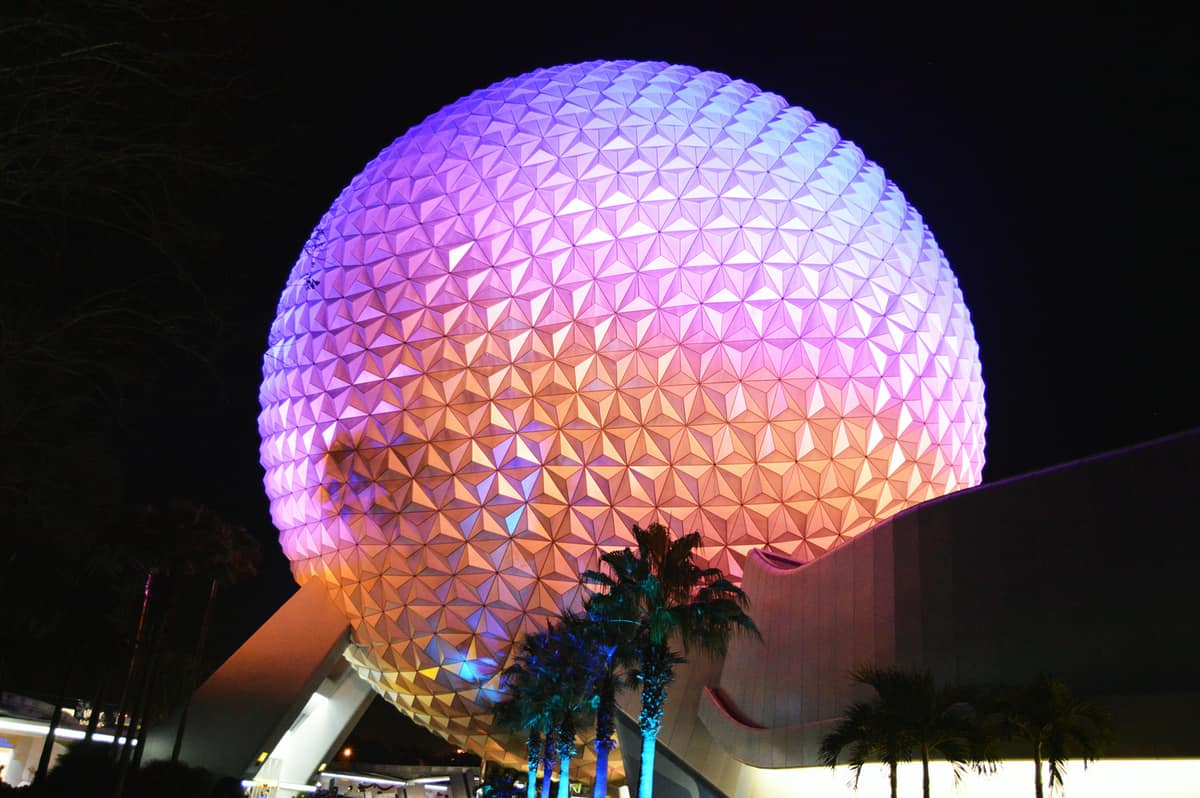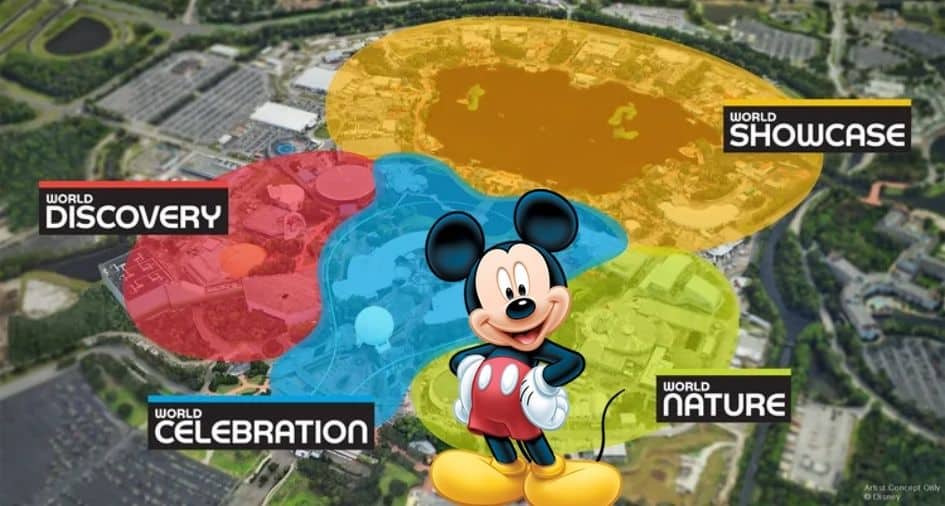
EPCOT. Epcot. . The of Tomorrow.
‘s “second gate,” EPCOT, has been many things – and had many names – over the course of its 40-year existence, ranging from a plan for an actual city through to a , a “permanent world’s fair,” a source of edutainment, and a place where Every Person Comes Out Tired. Which begs the question – ?
More than any other – with the possible exception of Disney’s California Adventure – EPCOT has changed its focus, purpose, and target audience over the years, a constant work-in-progress that is still finding itself four decades on.
RELATED: EPCOT Is Getting a New Experience
Pre-1966 – A vision of tomorrow
I don’t believe there’s a challenge anywhere in the world that’s more important to people everywhere than finding solutions to the problems of our cities. But where do we begin; how do we start answering this great challenge?
We don’t presume to know all the answers. In fact, we’re counting on the cooperation of American industry to provide their best thinking during the planning and creation of our of Tomorrow.
So that’s what Epcot is: an that will always be in a state of becoming. It will never cease to be a living blueprint of the future.
These words – spoken by himself in a film made in the fall of 1966, just months before his death – proved to be prophetic when it came to the way EPCOT has evolved over the years since it was planned and built.
As Walt originally envisioned EPCOT, it was something quite far away from the it would someday be. As the cornerstone of his Disney “Florida Project” – which would eventually become the Walt Disney World Resort – EPCOT was one of the two main impetuses for Walt to want to open an east coast Resort (the second being, of course, to bring in tourist money from Americans living east of the Mississippi).
RELATED: More EPCOT Expansion Is on the Way
Having created an (at the time) much-lauded piece of urban planning in California’s Disneyland, Walt wanted to expand his reach and build an actual urban space where people lived, worked, and played. The part of – what we now know as the – was largely intended to fund this massive urban project. Scholar Priscilla Hobbs explains this development in her book Walt’s Utopia: Disneyland and American Mythmaking:
With Disneyland, [Walt] implemented the vision of ideal mythscape, but quickly became disheartened when seedy hotels plagued the area surrounding the park. When he bought the land in Florida, he purchased enough land to help him fully actualize his utopian dream. In the 1966 promotional film, EPCOT, Walt presents plans for his utopia. Borrowing from the image of a wagon wheel, EPCOT was designed with the commercial center in the middle, with residential districts radiating off like spokes. Trash and traffic were kept away from the main view of the people with the intent of promoting safety and recreation, especially for children. Monorails and WEDWay People Movers would transport residents to and from school or work in the center or in the adjacent industrial area. His plans suggested a fully self-sustainable, eco-friendly, community-centered environment.
While we may think of EPCOT as a symbol of optimistic futurism within a milieu, in another world we might simply be talking about it as a planned community our friends moved to after college.
In this world, however, died in 1966, and with him went this original vision of EPCOT.
1966-1982 – A emerges
After Walt’s death, his brother Roy took over the company just long enough to oversee the completion and opening of , which Roy renamed in his brother’s honor. However, when the opened in 1971, there was no community – experimental, prototypical, or any other kind – that opened along with it.
RELATED: Disney Just Released The Recipe For This Delicious EPCOT Dessert
This was because the original “urban utopia” version of EPCOT was such a personal vision that it wasn’t something the wanted to invest in without Walt himself at the helm. Instead, they decided to move forward with a kind of compromise vision of EPCOT that, while explicitly a , was themed around the concept of utopian futurism. When it opened in 1982 as (its official title until 1994), this new took a new and unique approach that was wildly different to either Disneyland or the .
1982 – 1994 – A world’s fair for the ages
To express Walt’s utopian vision in this new form, the original (as it was known until 1994) was divided by the Disney Imagineers into two halves – “,” featuring various pavilions dedicated to the history, present, and future of specific aspects of technology (such as ‘s focus on communication and World of Energy’s focus on, well, energy), and “,” consisting of pavilions themed to various nations and sponsored by either the countries themselves or by private companies affiliated with those countries.
As Marty Sklar, the long-time head of , explained in ‘s : Creating the New World of Tomorrow (the celebratory book published when EPCOT opened), this was a with a utopian inspiration. Although the had been successfully operating for over a decade,
What was lacking was a public focus for new ideas and concepts, a “center” for the communication of new possibilities for the future-directly to the public. To answer this need, we are developing : a permanent world’s fair of imagination, discovery, education, and exploration that combines the Disney entertainment and communications skills with the knowledge and predictions for the future of authorities from industry, the academic world, and the professions. Our goal is to inspire the visitors who come here, so that they will be turned on to the positive potential of the future and will want to participate in making the choices that will shape it.
With a focus on education and inspiration, though, what the original was lacking in was fun. While the remained a realm of whimsy and magic for children and their parents, appealed to an older audience. Except for the Imagination pavilion, with its whimsical mascot Figment, the rides – even the iconic – put pedagogy front and center, while World’s Showcase was home to more films, restaurants, and shops than rides that would appeal to children.
had its many die-hard fans, however, and it was a huge success in its first decade or so of life. However, by the mid-90s, Disney was reminded of a lesson they had already learned with Disneyland and the ‘s Tomorrowland – though magic, whimsy, adventure, and historical themes may be timeless, our visions of the future become thoroughly dated shockingly soon. What’s more, even the Kidcot Fun Stops couldn’t make appealing to young kids.
RELATED: The History of That Lovable Fellow, Figment
1994 – 2016 – A festival center
By 1994, most of the attractions were in dire need of updates, if not entire redesigns. While this process slowly transpired over the next several years, Disney introduced a new concept to EPCOT that would at least keep Guests coming through the gates – the season(s).
In 1994 and 1995, respectively, EPCOT held its first International Flower & and International Food & , seasonal events meant to appeal to Florida locals as much as to the tourist trade that makes up the bulk of ‘s patrons. However, turning a billion-dollar into a place for a and a food & for a local audience is ultimately only a stopgap measure, and Disney realized that EPCOT was going to require permanent changes.
RELATED: Is the Rest of EPCOT’s Overhaul Still Happening?
2017-Present/Future – An evolving brand
In 2016, those changes began in earnest, as one of the two rides in – Norway’s Maelstrom dark , which had closed in 2014 – was replaced with Frozen Ever After, themed to the popular animated film Frozen. Along with this new came the inescapable conclusion that Disney IP was coming to EPCOT in earnest.
For three decades, Disney has resisted adding its characters and films to EPCOT; in fact, for many years, no Disney characters (except for Figment, as an original creation for the park) would even appear at EPCOT. Though this restriction slowly loosened over the years, it wasn’t until 2006 that an attraction themed to a (non-original) Disney character or movie opened with the retheming of The Living Seas as The Seas with Nemo & Friends. Shortly thereafter, in 2007, ‘s other , Mexico’s El Rio del Tiempo, was updated to the Donald Duck-starring Starring The Three Caballeros, though these changes were milder compared to Maelstrom’s later transition into Frozen Ever After.
In 2017, though, Disney made the IP infusion official, announcing that EPCOT would be undergoing a multi-year redesign and expansion that would include Guardians of the Galaxy: and . Following up on this, during 2019’s the biggest change to EPCOT, ever, was announced, just in time for ‘s 50th anniversary – would cease to be, replaced with three new “neighborhoods” called , , and .
RELATED: Final Goodbyes to EPCOT’s Iconic
This cleared the path for a move away from Walt’s original futurist utopianism and into a more traditional that could comfortably house a variety of attractions based on Disney’s intellectual property (much like Disney’s has used different lands to fit IP within the overarching theme of conservation).
That’s where EPCOT stands at the moment, but if one thing is clear, this “community of tomorrow” is constantly on the move, and so are the ‘s plans for it. So , and what will it become? Will , , and survive as long as did?
Will Disney IP suffuse the park, including such mainstays as , with more thrill rides like ? Or will the pedagogical bent make an unexpected turn? That might be something that only tomorrow’s child will discover.

 DisneyTips.com Your Guide To A Great Disney Vacation
DisneyTips.com Your Guide To A Great Disney Vacation








